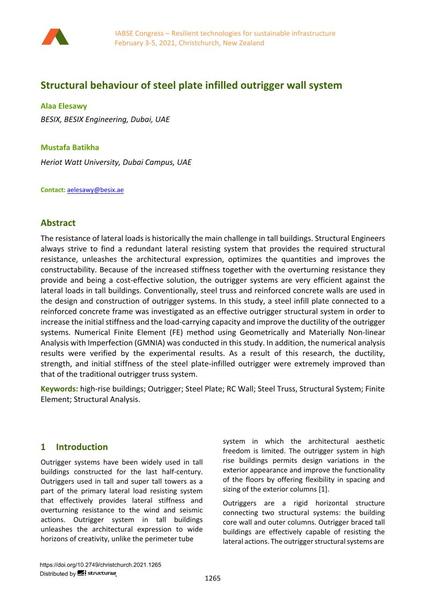Structural behaviour of steel plate infilled outrigger wall system

|
|
|||||||||||
Bibliografische Angaben
| Autor(en): |
Alaa Elesawy
(BESIX, BESIX Engineering, Dubai, UAE)
Mustafa Batikha (Heriot Watt University, Dubai Campus, UAE) |
||||
|---|---|---|---|---|---|
| Medium: | Tagungsbeitrag | ||||
| Sprache(n): | Englisch | ||||
| Tagung: | IABSE Congress: Resilient technologies for sustainable infrastructure, Christchurch, New Zealand, 3-5 February 2021 | ||||
| Veröffentlicht in: | IABSE Congress Christchurch 2020 | ||||
|
|||||
| Seite(n): | 1265-1272 | ||||
| Anzahl der Seiten (im PDF): | 8 | ||||
| DOI: | 10.2749/christchurch.2021.1265 | ||||
| Abstrakt: |
The resistance of lateral loads is historically the main challenge in tall buildings. Structural Engineers always strive to find a redundant lateral resisting system that provides the required structural resistance, unleashes the architectural expression, optimizes the quantities and improves the constructability. Because of the increased stiffness together with the overturning resistance they provide and being a cost-effective solution, the outrigger systems are very efficient against the lateral loads in tall buildings. Conventionally, steel truss and reinforced concrete walls are used in the design and construction of outrigger systems. In this study, a steel infill plate connected to a reinforced concrete frame was investigated as an effective outrigger structural system in order to increase the initial stiffness and the load-carrying capacity and improve the ductility of the outrigger systems. Numerical Finite Element (FE) method using Geometrically and Materially Non-linear Analysis with Imperfection (GMNIA) was conducted in this study. In addition, the numerical analysis results were verified by the experimental results. As a result of this research, the ductility, strength, and initial stiffness of the steel plate-infilled outrigger were extremely improved than that of the traditional outrigger truss system. |
||||
| Stichwörter: |
Schnittgrößenermittlung Hochhäuser finites Element statisches System
|
||||
